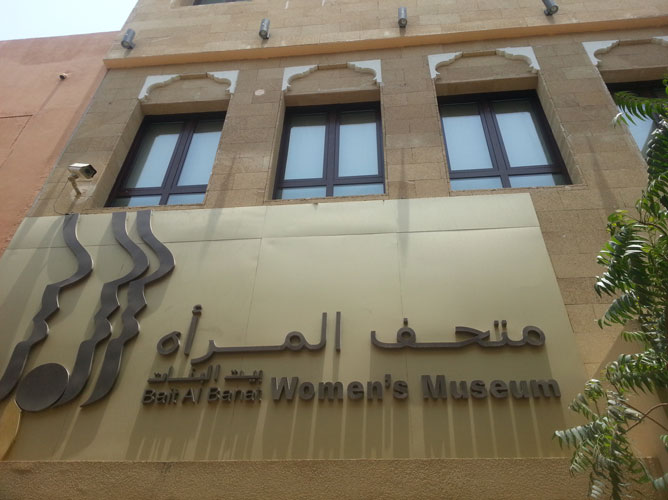When I think of women rights, I do not think of a history of fights for these rights as is the case in some countries. No, I believe I was born with these rights. I have a feeling of freedom inside me, and I do not need any government to grant me that feeling."
These were the words of Rafia Ghubais, founder of the Women's Museum when she explained why the role of women had become the theme of her historic showpiece.
The museum, tucked away in the narrow alleys of what people still refer to as 'the original Dubai' is the refurbishment of what use to be bayt al binat, or girls house, because it housed three unmarried women.
 [Artwork made of burkas]
[Artwork made of burkas]
As a child, Rafia had been send by her mother to visit the women many times. Yet, the woman as a theme was not the first thing that had come to her mind when she thought of opening a museum.
"This area of Dubai (the Gold Souk area) was once the heart of Dubai. Now there is not much left that traces back to these roots. I wanted to give something to the community that would preserve that part of history," Rafia explains.
A practicing psychiatrist while holding the position of president of the Arabian Gulf University in Bahrain and President of the Arab Network for Women in Science and Technology, Rafia could say with ease that she has left her imprint on society herself.
However, the museum has temporarily diverted her efforts away from the academic world. By establishing a women's museum, she launched the first-of-its-kind in the region, and the fourth such museum worldwide.
 [UAE women in politics]
[UAE women in politics]
The venue exhibits the role women have played in shaping the history of the UAE, as well as their personal memories of the place. "Women in the UAE have always played a great role in shaping this society. But they have not had the chance to be seen," says Rafia.
We meet Sheikha Salama bint Boti, the mother of the President His Highness Sheikh Khalifa bin Zayed Al Nahyan. "At her time, Abu Dhabi went through a time of political instability. There were a lot of fights between the different tribes, and vengeful killings took place. But Sheikha Salama raised her children emphasizing non-violence, and they promised her never to seek revenge. She paved the way for just and peaceful leadership," explains Hawra Askari, museum coordinator to the crowd.
A little further, we see how the first girls' schools came into existence. "At first, people were reluctant to send their daughters to school. So the late Sheikh Rashid sent his daughter to school. After that many people followed," learns the public.
Accessories, fashion items, cosmetics and jewellery could not be left out in a women's museum, agrees Rafia, although she admits that she did not want these items to be at the center of the museum. "Everybody expects to find such items in a women's museum, so I wanted expose them in a different way."
 [Poetry by Ousha bint Khalifa]
[Poetry by Ousha bint Khalifa]
An artwork made out of burka's covers one of the museum walls. "The role of the burka is superior in my generation. For some younger people it has become an item to joke around with, but this hurts."
The pieces shaped like a mask covering parts of the face are style of burka typical of the GCC. According to the tradition, a woman starts wearing the burka when she gets married. The younger she is, the bigger the open space of the burka, she explains.
And there is a lot more to discover. While the ground floor showcases the most ordinary items, art works found place on the first and second floor, with a room dedicated to Emirati artists, another one to international artists, a corner of the museum covered in poems of the famous Ousha bint Khalifa, and a section dedicated to the President His Highness Sheikh Khalifa bin Zayed Al Nahyan, who deserves such place because of his enduring encouragement of women's empowerment, said Rafia.
Yet, the abundance of information is working against the museum. While locals and residents are certainly interested to learn more about the history of the UAE, tourists seem to be a harder catch.
 [The Women's Museum in Dubai ]
[The Women's Museum in Dubai ]
"I have approached many tourist companies. But not one has made it to the museum. Their argument is that the tourists would not have the time to read," she says.
"They come to the Gold Souk because they get commission when the tourists buy something. But they do not want to spend 30 minutes in the museum. That would be too long."
 Follow Emirates 24|7 on Google News.
Follow Emirates 24|7 on Google News.

 [Artwork made of burkas]
[Artwork made of burkas] [UAE women in politics]
[UAE women in politics] [Poetry by Ousha bint Khalifa]
[Poetry by Ousha bint Khalifa] [The Women's Museum in Dubai ]
[The Women's Museum in Dubai ]![]() Follow Emirates 24|7 on Google News.
Follow Emirates 24|7 on Google News.